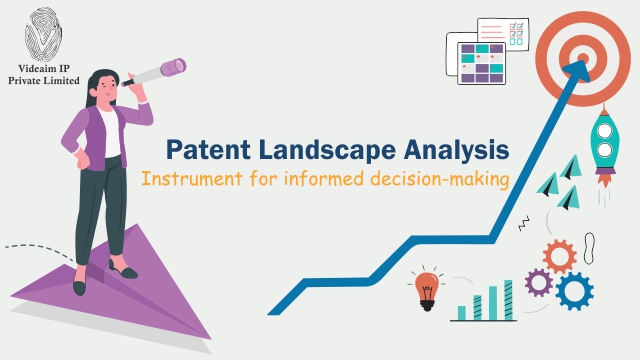
A patent landscape refers to the overall view of patents in a particular field of technology or industry. It involves analyzing and mapping the patent information related to a specific area to understand the competitive landscape, identify trends, and gain insights into innovation and technological development.
Content of a Patent Landscape Analysis
- Specifying Scope, Objective and Definition: Defining the scope of the landscape, specifying the technology or industry of interest, and clearly articulate the objectives and goals of the patent landscape analysis.
- Searching and Data Collection: Conducting comprehensive searches of patent databases to gather relevant patent documents incorporating information on patent titles, abstracts, claims, and drawings.
- Categorization and Classification: Categorize patents based on technology, application, or other relevant criteria and classifying them using international patent classification systems.
- Trend Analysis: Identifying emerging trends and patterns within the patent data and analyzing the evolution of technology over time.
- Competitor Analysis: Identifying key players and stakeholders in the field and evaluating the strengths and weaknesses of competitors based on their patent portfolios.
- Geographical Analysis: Analyzing the geographical distribution of patents to identify regions with high innovation activity.
- Legal Status and Citations: Assessing the legal status of patents, including whether they are active, expired, or pending and examining citation data to understand the influence and impact of patents within the landscape.
- Licensing and Collaboration Opportunities: Identifying opportunities for licensing or collaboration based on the patent landscape and evaluating the potential for partnerships or joint ventures.
- Risk Assessment: Evaluating potential risks, such as the presence of blocking patents or legal challenges and assessing the freedom to operate within the landscape.
- Visual representation of data: Creating visual representations of the patent landscape, such as maps, charts, or graphs, to facilitate easy interpretation.
Importance and Benefits of Patent Landscape Analysis
Patent landscape analysis provides valuable insights into the intellectual property (IP) environment of a specific technology or industry and helps in making valuable decisions as follows:
- Informed Decision-Making: Businesses can make informed decisions regarding research and development, investment, and strategic planning based on a thorough understanding of the patent landscape. It helps them identify opportunities and risks associated with specific technologies.
- Competitive Intelligence: Patent landscapes offer a comprehensive view of competitors’ activities and technological advancements. Companies can analyze the strengths and weaknesses of their competitors’ patent portfolios, helping them stay ahead in the competitive landscape.
- Identification of Emerging Trends: By analyzing patent data, one can identify emerging trends and areas of innovation within a particular field. This information is crucial for staying ahead of the curve and anticipating future developments in technology.
- Technology Mapping: Patent landscapes allow for the mapping of technologies within a specific domain. This helps in understanding the interconnectedness of various technologies, facilitating the identification of potential cross-industry collaborations and opportunities.
- Risk Management: Businesses can assess potential risks associated with entering a particular market or developing a new product. Patent landscapes help in identifying existing patents that may pose obstacles or risks to a company’s freedom to operate.
- Licensing and Partnership Opportunities: Companies can identify opportunities for licensing or forming partnerships based on the patent landscape. This can lead to mutually beneficial collaborations, allowing companies to leverage each other’s strengths and intellectual property.
- Intellectual Property Portfolio Management: For organizations with existing intellectual property portfolios, it helps in managing and optimizing the patent portfolios. It provides insights into potential areas for portfolio expansion, pruning, or licensing.
- Market Entry and Expansion: Companies looking to enter new markets can use patent landscapes to understand the IP landscape in those markets. This information is valuable for making informed decisions about market entry and expansion strategies.
Conclusion
A patent contains technical and legal information. A patent landscape analysis provides meaningful information about the competitors, the level of their R&D, their technological roadmap and the future products that might come in the field.
